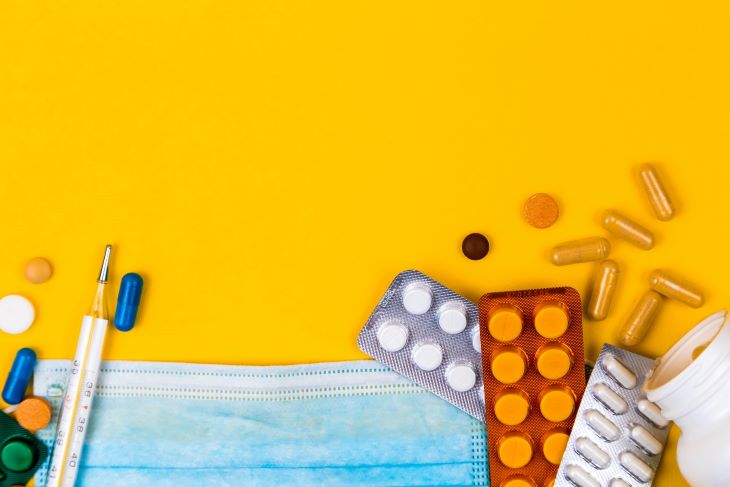Heroin was originally known as diamorphine and is in the opioid drug class, it is principally recognised and used for its analgesic effects and so was utilised when first discovered in the medical arena because of its effectiveness in helping people deal with pain.
Heroin is derived from the opium poppy plant and is technically a semi-synthetic opioid drug, this means it is made up of natural and man-made chemicals.
It has been reported to be the most commonly used opioid drug in the world and the World Health Organisation estimates that there are over 12 million heroin users worldwide. (15)
Heroin is a psychoactive drug which means that it contains properties that can alter the way our brain and central nervous system function, because of this it can produce feelings of pleasure, euphoria and excitement in the people who consume the drug.
Heroin has therefore now developed a reputation as a recreational drug that thrill seekers can ingest to improve their mood and provide themselves with an adrenaline-charged mind and consciousness-altering experience.
People seeking to take heroin can smoke the drug, ingest it through their nose or inject it into their veins. (4)

One of the main reasons why so many people seek to use heroin is that it is a fast-acting drug that users tend to feel the effects of fairly rapidly after taking it.
Heroin has a half-life of 2.5 to 3 hours meaning it takes the body 2.5 – 3 hours to break down and get rid of the toxic effects of half of the drug that is taken.
Because heroin is processed efficiently drug users can develop a tolerance to the drug very quickly if they start to take the drug consistently which means it has huge potential to be addictive as its pleasurable effects do not last for too long resulting in people wanting (or needing) to take the drug again to experience its positive effects. (4)

As a psychoactive, drug heroin possesses chemicals that effortlessly attach to compatible opioid receptors in the human brain, the more a person takes heroin the more opioid receptors the body will produce which will only result in stronger cravings.
This will eventually have a significant effect on both the biological structure and functioning of the central nervous system and areas of the peripheral nervous system.
Heroin is capable of altering our mood, particularly by providing us with positive emotional experiences which only serves to strengthen its addictive qualities.
This occurs because key chemical elements in heroin activate areas of the dopaminergic pathway (also known as the reward centre) which is an area of the brain acknowledged as governing our emotional life and the state of our mood. (9)
Neuroadaptation is a term used to describe how the body, brain and central nervous system respond when a person consumes a psychoactive drug like heroin.
When someone consumes heroin the body automatically initiates a physical process which intends to break down the drug and eliminate it from the body as quickly and efficiently as possible.
If a person then continues to take heroin the brain and nervous system have to adapt to the regular presence of heroin in the bloodstream and make physical adjustments so that they can carry on functioning as effectively as possible with heroin present in their system.
The physical adjustments are carried out by a process called neuroadaptation. (9,15)
The process of neuroadaptation eventually leads to a physical dependence on heroin. When heroin users continue to take the drug or even increase their use they will find that they will build up a tolerance to the drug.
This means that they will need to consume more heroin to obtain the same intensity of positive emotions they experienced when they first took the drug.
Another key principle in explaining physical dependence on heroin is withdrawal because people diagnosed with an opioid use disorder (heroin addiction) have developed a strong tolerance to the drug if they stop taking the drug suddenly they will experience extremely unpleasant withdrawal symptoms.
This is because their bodies have become accustomed to processing heroin and learned to function with the drug present in their system.
If a person suddenly stops taking heroin then their brain and central nervous system will be thrown into a state of chaos, the result of which generate withdrawal symptoms. (4,15)
Some of the main physical symptoms associated with heroin withdrawal include:
People addicted to heroin also develop a psychological dependence on the drug, this occurs because the substance user has become reliant on heroin to provide them with a psychological boost or emotional crutch to help them deal with aspects of their life that they have been unable to find elsewhere.
This could be to boost a low mood or to find some relief and comfort from a stressful life. (9,12)

There are many physical health problems resulting from excessive heroin consumption apart from being physically addictive which can be very damaging and dramatically limit many areas of a person’s life including their health, education and career, personal relationships and recreational activities.
The physical health consequences of heroin addiction include:
Because of its highly addictive qualities, the severity of the withdrawal symptoms generated and the intense cravings it produces heroin addiction is a very challenging condition to conquer and this is reflected in the high relapse rate for the condition.
A very high percentage of people who enter rehab for heroin addiction do end up relapsing at various stages in their recovery journey, many of these have made significant progress and seemed to have turned things around but do end up relapsing after going through an emotional crisis or after being triggered by people or situations from their environment. (12)

When assessing patients for heroin addiction clinicians tend to refer to the Diagnostic and statistical manual for mental health disorders, the most recent version (5th) sets out the following criteria for diagnosing an opioid use disorder which is now the modern diagnostic clinical term for heroin addiction:
Medical experts and drug rehab practitioners recommend a long-term approach to treating patients with heroin addiction, and they also proposed that special considerations need to be factored in along the way at various stages of the treatment schedule to prevent people who appear to be making progress from relapsing back into heroin use.
In order to facilitate this, it is recommended that all patients entering rehab for heroin dependence analyse many aspects of their lifestyle and not just focus on their addiction to heroin.
Any heroin rehab programme should therefore adopt psychological, emotional, spiritual and recreational strategies to help the patient get better. (9,16)

There are two options available for receiving treatment for heroin addiction, one option is a residential inpatient programme where patients will work on their recovery for a minimum 28-day programme and the other is an outpatient programme where patients can receive the same biological (detox) and psychological interventions but can live at home with their family while working through the programme.
Which option is most suitable for anyone person depends on their own personal circumstances although anyone diagnosed with severe heroin addiction and who has already relapsed on an outpatient programme may be recommended to join an inpatient programme.
Patients who live in a tumultuous living environment with no support available from close friends and family and with many negative influences around them may also find that outpatient programmes are unsuitable for them.
However, highly committed patients who appear determined and live with understanding and compassionate family members could well be recommended to join an outpatient programme, to begin with.
As well as helping patients stop or reduce their heroin use addiction specialists are also keen to reduce the current and future negative physical consequences of their excessive heroin use and improve the quality of several areas of the patients’ lives including their psychological, social and spiritual well-being.
That is why rehab practitioners adopt a biopsychosocial and spiritual approach to their treatment programmes and include interventions to help patients improve these areas of their lives. (16)

Initially, when entering rehab treatment all clients will be assessed for the severity of their physical dependence on heroin so that rehab medical practitioners can design their specially tailored detoxification programme which is based on the use of prescribing substitute drugs to help patients slowly eradicate the presence of heroin from their bodies.
Patients who have been assessed as having increased tolerance to heroin will find they need to increase their consumption of the drug to experience the positive effects that they desire.
If they then stop consuming heroin then they will experience unpleasant side effects known as withdrawal symptoms.
Their body has become used to functioning while taking heroin and if they then decide to stop the body will need to go through a process of readjusting to the absence of heroin, which leads to physical consequences known as withdrawal symptoms. (4)
Anyone who has reached this point will be physically dependent on heroin and in need of detox treatment to get rid of the harmful traces of heroin from the bloodstream.
The greater the amount of heroin present in the bloodstream the more intense and unpleasant the withdrawal symptoms will be.
This is usually related to the amount of heroin that a person has consumed over the years which usually also determines the severity of their addiction.
Substance users who have been consuming high amounts of heroin consistently over several years will experience very intense and uncomfortable withdrawal symptoms when they stop taking heroin, and in some cases may be taking a substitute drug for months or placed on a drug maintenance programme. (9,16)
Medical practitioners treating heroin addiction have used a synthetic opioid drug called methadone to help with the withdrawal process since the late 1960s.
It has proven to be a reliable treatment to aid the withdrawal process because it is a significantly slower-acting drug with a longer half-life than heroin.
This means the body takes longer to process methadone and its chemicals are released slowly into the body over a longer period of time than heroin, and also keep withdrawal symptoms at bay for at least 24 hours, something the faster-acting heroin is unable to do. (8,11)
In the short term, this means that patients no longer need to take heroin several times a day which is a result of the rapid onset of withdrawal symptoms (a common feature of fast-acting drugs).
Another benefit of methadone is that people who take the drug do not experience any pleasurable and euphoric feelings after taking the drug which means it also helps to reduce the patient’s psychological dependence on the drug. (10)
Another pharmacological intervention used to facilitate heroin withdrawal is a part opioid agonist called Buprenorphine, this drug possesses chemical components that in contrast to heroin do not completely attach to the opioid receptors located in the human brain and cause euphoric feelings.
Buprenorphine acts by occupying slots in the brain’s opioid receptors and therefore blocking the effects of any heroin which is subsequently taken by substance users, as Buprenorphine has taken up the space normally taken by heroin’s chemicals and therefore heroin is not able to have any effect on the user. (11,16)
Clinical research has shown that when patients take buprenorphine they are statistically less vulnerable to having an overdose compared to those taking methadone to help them withdraw. Buprenorphine has also been proposed to be less likely to negatively impact patients’ respiratory systems in comparison with methadone.

Treatment centres include several psychological therapies in their heroin rehab programmes, which patients can commence once their detox procedure has been completed.
These therapies include;
CBT plays a key role in helping clients identify and adjust their illogical and negative thought patterns that for so long have contributed to their poor self-esteem, and lack of self-belief and also maintained their heroin use.
Patients may incorrectly believe for example that heroin is the only option open to them to improve their mood and cope with the demands of everyday life. (1)
This form of therapy teaches patients important self-regulatory skills which they have so far been unable to demonstrate.
Many heroin users tend to have difficulty handling strong emotions and their usual response is to resort to heroin use to numb painful feelings DBT therapists will work with clients to teach them cognitive strategies designed to help them withstand negative emotions without becoming overwhelmed.
These regular one-to-one sessions begin very early on in a patient’s psychological rehabilitation and carry on throughout treatment.
These sessions are important to ensure patients are still fully committed to treatment and motivated to overcome their addiction. MI therapists will build strong, trusting relationships with clients and help them overcome any psychological barriers they may face whilst working through their treatment programmes. (7)
Group therapy sessions are a regular feature on most patients’ heroin rehab treatment plans, these sessions help group members relearn the necessary psychological and behavioural abilities to make strong connections with people.
Working in a group with others can help members understand their psychological processes and understand how their behaviour affects other people.
The group also provides a supportive environment for members to respect and encourage each other in their progress towards recovery and to appreciate the point of view of other people in their group.
Academics who have researched addiction have found that many people who are diagnosed with a heroin addiction experienced significant disruption to their social and emotional development during their early development within the family system which may have significantly contributed to their heroin use.
Family therapy will help to unearth the route of any of these developmental difficulties and help the family communicate more effectively with each other, or help them resolve any traumatic and emotional experiences they were unable to discuss which may have affected the whole family dynamic.
AA’s 12-step programme has been modified into a form of therapy that is used to treat patients diagnosed with heroin addiction.
The 12 steps represent a sequence of reflective challenges that patients must work through to help them understand the reasons behind their heroin use and what they need to do to move forward and stop taking the drug.
The first step involves accepting that you are addicted to heroin and that your life has become uncontrollable because of your excessive heroin use.
Other steps include making an open and honest appraisal of your behaviour and character and recognising the people you have hurt over the years as a result of your heroin addiction. (9,14)
Practitioners treating heroin addiction have in recent times integrated holistic therapies into their treatment plans. These therapies offer a valuable treatment alternative to the main traditional therapies used, which are predominantly talk-based.
Interventions such as music, art therapy, equine therapy and drama therapy do offer some clients another avenue to express and explore difficult, traumatic emotions and experiences which may have been lying dormant for years.
Each individual has a different processing style and holistic therapies help facilitate patients’ ability to access the right side of the brain to process any unresolved emotions and repressed memories, as opposed to the left side of the brain which therapies such as CBT and psychotherapy work on.
Music and art therapy have been reported to be very helpful in allowing patients with trauma-based addictions to work through difficult processes relating to power, spirituality and denial.

As previously mentioned heroin addiction has a huge potential for relapse so it is essential for treatment providers to offer clients comprehensive relapse prevention programmes during their rehabilitation to ensure they do not relapse back into heroin use once they have completed their rehab programmes. (3,16)
Relapse prevention programmes tend to include the following;
There is medication available that can significantly help patients avoid relapsing back into heroin use, and a drug called Naltrexone contains chemicals that eradicate the effects produced by heroin.
Naltrexone contains chemicals that connect to opioid receptors in the brain and therefore obstruct the space that would be taken by toxic chemicals in heroin that contributes to the addictive process, so if a person consumed heroin after taking Naltrexone its effects would be redundant.
It is imperative however that a patient who is prescribed Naltrexone has been through both detox treatment and psychological rehabilitation and has been abstinent for a while before they begin a course of Naltrexone.
This is because it is important that there are no physical signs of heroin left in the body before the patient begins taking the drug as its effectiveness will be severely compromised. (16)

Some organisations can offer valuable support, guidance and knowledge for patients seeking to overcome heroin dependence and people can contact these organisations immediately for support which can make a huge difference to their well-being.
These organisations are available at the start of your recovery journey, during your recovery journey and after you have completed rehab and require ongoing support to maintain your progress.
NA is based on the same principles as Alcoholics Anonymous and aims to offer weekly meetings for individuals whose lives have been affected by excessive drug use.
The regular weekly meetings they offer throughout the UK enable attendees to talk about their feelings and experiences relating to their drug use in the presence of substance users who have been through similar circumstances, and with whom they share similar challenges and dilemmas.
The principle of fellowship and mutual support plays a huge role in enabling NA members to develop the courage and motivation to do what is necessary to achieve abstinence.
NA members will also learn about what is required of them to work through the 12-step programme, which is recognised as a key aspect of their recovery programme.
SMART Recovery is a UK-based charity dedicated to helping and supporting people as they work through their recovery from substance use and behavioural addictions.
They offer a free service and run meetings and educational programmes online and face to face in which they teach their students important psychological skills and coping mechanisms designed to help them cope with the challenges of overcoming an addiction.
Their sessions help clients to deal with stressful situations and manage the negative thought processes and powerful cravings associated with heroin dependence.
They also run personal development courses which help people improve their communication and social skills and help them understand the importance of living a balanced life.
If you or a loved one require heroin rehab or heroin detox service, contact Rehab 4 Addiction today on 0800 140 4690, or alternatively, contact us through this website.
(1) Bennett, P. (2003) Behavioural and Cognitive Behavioural Approaches to Substance Misuse Treatment in Peterson, T. & McBride, A. (ed) Working with Substance Misusers: A Guide to Theory and Practice London. Routledge.
(2) Black, D., Grant, J. (2013) DSM5 Guidebook: The Essential Companion to Diagnostic and Statistical Manual of Mental Disorders, 5th Edition. APP. London.
(3) Gossop, M. (2003) Relapse Prevention in Peterson, T. & McBride, A. (ed) Working with Substance Misusers: A Guide to Theory and Practice London. Routledge.
(4) Kahan, M. (2014) Physical Effects of Alcohol and Other Drugs. In Herie, M. & Skinner, W. (ed) Fundamentals of Addiction: A Practical Guide for Counsellors. CAMH. Canada.
(5) McBride, A. (2003) Some Drugs of Misuse in Peterson, T. & McBride, A. (ed) Working with Substance Misusers: A Guide to Theory and Practice London. Routledge.
(6) Merrill, J. (2003) Medical Approaches and Prescribing: Drugs in Peterson, T. & McBride, A. (ed) Working with Substance Misusers: A Guide to Theory and Practice London. Routledge.
(7) Miller, W. & Rollnick, S. (1991) Motivational Interviewing: Preparing to Change Addictive Behaviour. Guilford Press. New York.
(8) Morse, G. (2007) Care of Opiate Users: Detoxification in Beaumont, B. (ed) Care of Drug Users in General Practice Radcliffe Publishing. Oxford.
(9) Moss, A, Dyer, K (2010) The Psychology of Addictive Behaviour. Palgrave McMillan. New York.
(10) National Institute for Health and Care Excellence (2007) Drug Misuse in Over 16s: Opioid detoxification available @Drug misuse in over 16s: opioid detoxification (nice.org.uk)
(11) NHS (2022) Methadone. Available@ Methadone – medicine used to treat heroin dependence – NHS (www.nhs.uk)
(12) Rassool, G.H. (2011) Understanding Addictive Behaviours. Palgrave MacMillan. New York.
(13) Skinner, W. Herie, M. (2014) Biopsychosocial Plus: A Practical approach to addiction and recovery in In Herie, M. & Skinner, W. (ed) Fundamentals of Addiction: A Practical Guide for Counsellors. CAMH. Canada.
(14) Williams, C. (2003) 12 Step Approaches in Peterson, T. & McBride, A. (ed) Working with Substance Misusers: A Guide to Theory and Practice London. Routledge.
(15) Wills, S. (2005) Drugs of Abuse. Pharmaceutical Press. London.
(16) Yoon, R. (2014) Opioid Addiction, in Herie, M. & Skinner, W. (ed) Fundamentals of Addiction: A Practical Guide for Counsellors. CAMH. Canada.